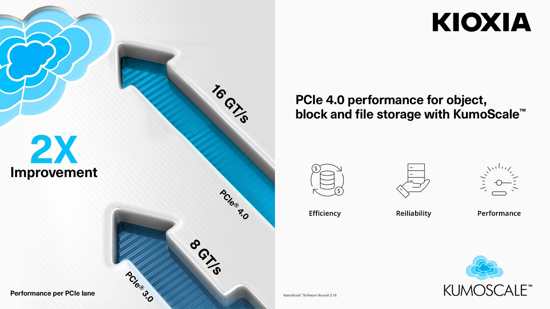Kioxia KumoScale V.3.18 Storage Platform Software With Support for OpenStack Infrastructure Wallaby Release
Native integration with OpenStack infrastructure Wallaby release and BGP-based multipath networking
This is a Press Release edited by StorageNewsletter.com on June 28, 2021 at 2:32 pmKioxia Europe GmbH has released version 3.18 of its KumoScale storage platform built around the NVMe-oF protocol.
Designed for deployment at data center scale, it delivers performance NVMe flash storage as a disaggregated networked service. Major features in version 3.18 include native integration with OpenStack infrastructure Wallaby release and BGP-based multipath networking.
OpenStack infrastructure wallaby release support
Version 3.18 includes native integration with the latest OpenStack infrastructure Wallaby release. An active member of the OpenStack Contributor Community, the company has made several enhancements to this open source infrastructure environment to integrate performance NVMe-oF storage resources seamlessly and reliably.
The firm’s contributions address 2 issues related to NVMe-oF storage in OpenStack environment:
-
In prior versions, the OpenStack infrastructure NVMe-oF connector opened a new resource-intensive connection for each and every volume, even if they shared the same target. This made NVMe-oF deployments compute and network intensive.
-
In prior versions, the OpenStack os-brick module did not take advantage of client md-raid capabilities to write directly to replicated volumes across multiple storage backends.
Company’s code contributions to OpenStack infrastructure Wallaby release for NVMe-oF native support include:
-
Refactored the OpenStack os-brick NVMe-oF connector (nvmeof.py) and upgraded it to support more recent NVMe-oF protocols.
-
Contributed an enhancement to the OpenStack infrastructure Wallaby release connector that supports client-side replication via md-raid.
-
Contributed a KumoScale software Cinder driver that seamlessly integrates KumoScale storage backends into OpenStack environments.
“As the adoption of the NVMe-oF protocol in modern Data center storage network architectures continues to accelerate, we are glad to offer the latest release of Kumoscale as part of the software stack,” said Frederik Haak, head, SSD marketing, Kioxia Europe. “With the code contribution to the OpenStack project, we ensure more efficient deployment of NVMe-oF based infrastructure to our customers.“
According to Brian Rosmaita, OpenStack Cinder Project Team Lead (PTL) and principal software engineer, Red Hat, “The Cinder development team and user community is excited that kioxia has made these technical contributions to the Cinder project, which provides the OpenStack Block Storage service. These new features will enable the OpenStack community to take advantage of the fast-evolving NVMe-oF protocol. Other driver maintainers are already looking at leveraging the updated os-brick connector to offer NVMe-oF with TCP, so the kioxia contribution, in addition to bringing KumoScale into the OpenStack family, is a real benefit to the entire OpenStack community of users.”
BGP L3 Multipath Networking Integration
Version 3.18 also includes a technical preview of its native support for the Border Gateway Protocol. (BGP), implemented via integration of the Free Range Routing (FRR) network routing software. It delivers the first multipath networking for NVMe-oF storage over TCP/IP networks [1]. A Clos network topology is often used by data center operators to build high-performance, scalable, cost effective, robust networks. Such networks use IP routing as the primary packet forwarding mechanism, and BGP is a popular routing protocol used in this type of environment. Storage system support for the BGP protocol enables storage resources to participate as a first-class citizen in a Clos network, allowing resilient, high bandwidth connectivity between client initiators and storage targets. Traditional storage interconnect uses layer 2 technologies, such as port channels, to connect into IP networks. By participating instead at layer 3 (i.e., IP routing), KumoScale storage systems enter the modern data center network as a native cloud service. Running BGP as the routing protocol allows them to provide reliable and dynamically reroutable L3 level multipath network connectivity between client initiators and KumoScale storage targets.
“BGP is commonly used in cloud native data center environments, where a small group of people can support a very large network due to the operational simplicity and network stability it provides,” said Dinesh Dutt, author of recently released book Cloud Native Data Center Networking. “Native support of BGP for NVMe-oF traffic enables storage to embrace IP routing to provide robust, high-performance connectivity for customers who wish to push the boundaries of storage networks.”
KumoScale software V.3.18 also includes several enhancements to its install and upgrade processes, end-to-end security and reporting telemetry, and a sample KumoScale software reporting dashboard built on Prometheus telemetry frameworks and Grafana platforms.
[1] As of June 8, 2021. Source: Kioxia Corporation














 Subscribe to our free daily newsletter
Subscribe to our free daily newsletter

